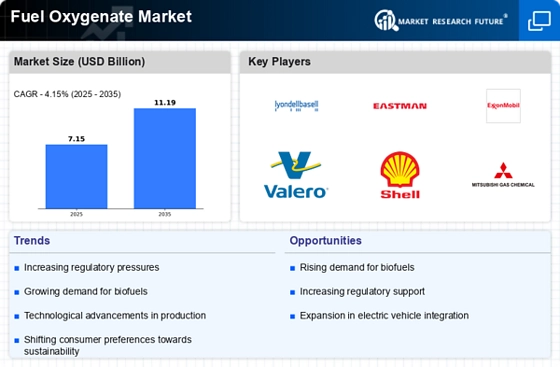Regulatory Support for Cleaner Fuels
The Fuel Oxygenate Market is experiencing a notable boost due to increasing regulatory support aimed at reducing emissions from transportation fuels. Governments are implementing stringent regulations that mandate the use of cleaner fuels, which often include oxygenates to enhance combustion efficiency. For instance, the introduction of policies that promote the blending of ethanol and other oxygenates in gasoline is becoming more prevalent. This regulatory framework not only encourages the adoption of fuel oxygenates but also aligns with broader environmental goals. As a result, the market is projected to grow, with estimates suggesting a compound annual growth rate of around 5% over the next few years. Such supportive measures are likely to drive innovation and investment in the Fuel Oxygenate Market.
Rising Demand for Renewable Energy Sources
The Fuel Oxygenate Market is witnessing a surge in demand for renewable energy sources, particularly biofuels. This trend is largely driven by the global shift towards sustainability and the need to reduce reliance on fossil fuels. Bio-based oxygenates, such as ethanol derived from corn or sugarcane, are increasingly being integrated into fuel formulations. Market data indicates that the consumption of biofuels is expected to reach approximately 200 billion liters by 2027, reflecting a significant increase in the use of fuel oxygenates. This growing demand is not only beneficial for the environment but also supports agricultural economies. Consequently, the Fuel Oxygenate Market is likely to expand as more stakeholders recognize the potential of renewable energy sources.
Technological Innovations in Fuel Production
Technological advancements are playing a crucial role in shaping the Fuel Oxygenate Market. Innovations in fuel production processes, such as improved fermentation techniques and advanced catalytic methods, are enhancing the efficiency and yield of oxygenate production. These technologies enable manufacturers to produce higher-quality oxygenates at lower costs, thereby making them more competitive in the market. Furthermore, the development of new formulations that incorporate oxygenates can lead to better engine performance and reduced emissions. As a result, the Fuel Oxygenate Market is expected to benefit from these technological innovations, with projections indicating a potential increase in market share for oxygenates in the coming years.
Economic Growth and Increased Transportation Needs
Economic growth in various regions is contributing to the expansion of the Fuel Oxygenate Market. As economies develop, there is a corresponding increase in transportation needs, leading to higher fuel consumption. This rise in demand for transportation fuels often necessitates the incorporation of oxygenates to enhance fuel performance and reduce emissions. Market data indicates that fuel consumption is projected to rise by approximately 3% annually, driven by urbanization and increased vehicle ownership. This trend presents a significant opportunity for the Fuel Oxygenate Market, as manufacturers seek to meet the growing demand for cleaner and more efficient fuels. The interplay between economic growth and fuel oxygenate adoption is likely to shape the market landscape in the coming years.
Consumer Awareness and Preference for Eco-friendly Products
Consumer awareness regarding environmental issues is significantly influencing the Fuel Oxygenate Market. As individuals become more conscious of their carbon footprint, there is a growing preference for eco-friendly products, including cleaner fuels that contain oxygenates. This shift in consumer behavior is prompting fuel producers to adapt their offerings to meet the demand for sustainable options. Market Research Future suggests that a substantial percentage of consumers are willing to pay a premium for fuels that are perceived as environmentally friendly. This trend is likely to drive the adoption of fuel oxygenates, as they are often associated with lower emissions and improved air quality. Consequently, the Fuel Oxygenate Market is poised for growth as it aligns with evolving consumer preferences.






















Leave a Comment